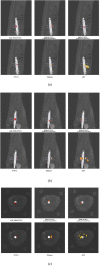Adaptive shrinking reconstruction framework for cone-beam X-ray luminescence computed tomography
- PMID: 33014562
- PMCID: PMC7510911
- DOI: 10.1364/BOE.393970
Adaptive shrinking reconstruction framework for cone-beam X-ray luminescence computed tomography
Abstract
Cone-beam X-ray luminescence computed tomography (CB-XLCT) emerged as a novel hybrid technique for early detection of small tumors in vivo. However, severe ill-posedness is still a challenge for CB-XLCT imaging. In this study, an adaptive shrinking reconstruction framework without a prior information is proposed for CB-XLCT. In reconstruction processing, the mesh nodes are automatically selected with higher probability to contribute to the distribution of target for imaging. Specially, an adaptive shrinking function is designed to automatically control the permissible source region at a multi-scale rate. Both 3D digital mouse and in vivo experiments were carried out to test the performance of our method. The results indicate that the proposed framework can dramatically improve the imaging quality of CB-XLCT.
© 2020 Optical Society of America under the terms of the OSA Open Access Publishing Agreement.
Conflict of interest statement
The authors declare no conflicts of interest.
Figures













Similar articles
-
Cone beam x-ray luminescence computed tomography: a feasibility study.Med Phys. 2013 Mar;40(3):031111. doi: 10.1118/1.4790694. Med Phys. 2013. PMID: 23464291
-
Limited view cone-beam x-ray luminescence tomography based on depth compensation and group sparsity prior.J Biomed Opt. 2020 Jan;25(1):1-14. doi: 10.1117/1.JBO.25.1.016004. J Biomed Opt. 2020. PMID: 31970943 Free PMC article.
-
Cone Beam X-ray Luminescence Computed Tomography Based on Bayesian Method.IEEE Trans Med Imaging. 2017 Jan;36(1):225-235. doi: 10.1109/TMI.2016.2603843. Epub 2016 Aug 26. IEEE Trans Med Imaging. 2017. PMID: 27576245 Free PMC article.
-
Cone-beam X-ray luminescence computed tomography based on MLEM with adaptive FISTA initial image.Comput Methods Programs Biomed. 2023 Feb;229:107265. doi: 10.1016/j.cmpb.2022.107265. Epub 2022 Nov 23. Comput Methods Programs Biomed. 2023. PMID: 36455470
-
Developments in and experience of kilovoltage X-ray cone beam image-guided radiotherapy.Br J Radiol. 2006 Sep;79 Spec No 1:S66-78. doi: 10.1259/bjr/68255935. Br J Radiol. 2006. PMID: 16980686 Review.
Cited by
-
Dual and Multi-Target Cone-Beam X-ray Luminescence Computed Tomography Based on the DeepCB-XLCT Network.Bioengineering (Basel). 2024 Aug 28;11(9):874. doi: 10.3390/bioengineering11090874. Bioengineering (Basel). 2024. PMID: 39329616 Free PMC article.
-
SODL-IR-FISTA: sparse online dictionary learning with iterative reduction FISTA for cone-beam X-ray luminescence computed tomography.Biomed Opt Express. 2024 Aug 12;15(9):5162-5179. doi: 10.1364/BOE.531828. eCollection 2024 Sep 1. Biomed Opt Express. 2024. PMID: 39296417 Free PMC article.
References
-
- Ahmad M., Pratx G., Bazalova M., Xing L., “X-ray luminescence and x-ray fluorescence computed tomography: new molecular imaging modalities,” IEEE Access 2(2), 1051–1061 (2014).10.1109/ACCESS.2014.2353041 - DOI
-
- Zhang S., Ma X., Wang Y., Wu M., Meng H., Chai W., Wang X., Wei S., Tian J., “Robust reconstruction of fluorescence molecular tomography based on sparsity adaptive correntropy matching pursuit method for stem cell distribution,” IEEE T. Med. Imaging 37(10), 2176–2184 (2018).10.1109/TMI.2018.2825102 - DOI - PubMed
LinkOut - more resources
Full Text Sources
